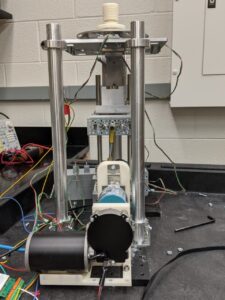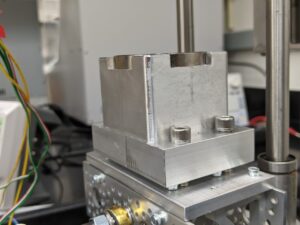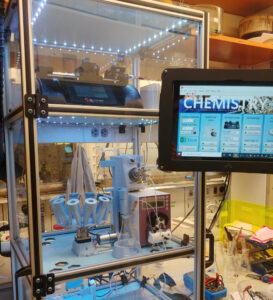Testimonials
BeAM Expands Research Opportunities
Nasal Positioning Devices
 “I’ve worked as an undergraduate researching in the Bennett Lab (CEMALB Department) for over a year. We work on a variety of lung biology projects, from inhalation toxicology to testing CPE and masks for COVID-19 protection.
“I’ve worked as an undergraduate researching in the Bennett Lab (CEMALB Department) for over a year. We work on a variety of lung biology projects, from inhalation toxicology to testing CPE and masks for COVID-19 protection.
The project I’ve used the makerspace for most recently involves an FDA grant to physically/experimentally determine the effectiveness of a CFD model for nasal spray deposition. In order to ensure the nasal spray release point is aligned to the CFD model, I created a “Nasal Positioning Device,” or NPD. I 3D printed the model in the makerspace, and here it is shown in the nose. I can get a better picture of it within in the actual testing environment soon.
I wouldn’t have been able to accomplish the rapid prototyping necessary to get the perfect NPD without the resources within the makerspace!” -Maddie Dyson
The MagnaPress
“Scientific research is expensive! As a graduate student in biomedical engineering, I found that even simple piece of equipment or basic reagent can cost hundreds of dollars. When I needed a device to aid my research in mechano-transduction, I knew commercial options would not be financially viable for me or my PI. I needed a machine that could efficiently apply cyclical compression at a variety loading patterns. Leveraging OEM components and the capabilities of BEAM, I was able to construct a custom device that directly catered to the needs of the project. Coined “The MagnaPress”, this in-house build does not compromise on accuracy or precision with close loop control logic and even includes a touch screen interface for improved accessibility. A commercial device with similar features would approach five figures in cost, while my PI out of pocket expense totaled just over thousand dollars. BEAM is not just for hobbyist, but a real resource for increasing capabilities and possibilities of scientific research on campus.” -Matthew Rich




Building Custom Reactors
“My research uses flow chemistry to synthesize novel polymers. The synthesis of these viscous materials requires innovation in flow reactor design and implementation. A challenge for our group is that commercially available reactors either did not offer the features we needed or were prohibitively expensive to purchase. BeAM proved to be an essential resource for my project. Using a variety of techniques including 3-D printing, laser cutting, and metal working we were able to build a custom reactor for our project that didn’t break the bank.
A resource I relied on heavily while becoming a maker was LinkedIn Learning (formerly Lynda.com). This site has a massive library of professionally made tutorial videos. Compared to sifting through youtube to find what you need, using Linked In learning expedited the process to become proficient at the tools needed to be a maker. The tutorials are very comprehensive and typically take about 5 hours to complete. I tutorials I found to be useful include 1.) Adobe Illustrator to easily create functional pieces using the laser cutter 2.) Fusion 360 to help design parts for 3-D printing. The best part is that this service is free to UNC students, so check it out before you graduate!” -Marcus Reis
